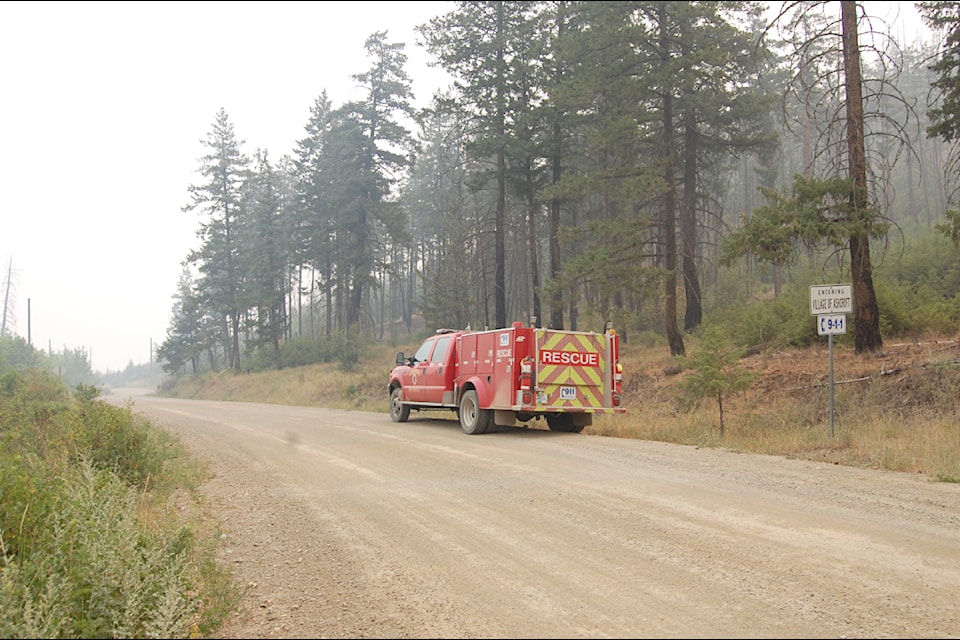The Village of Ashcroft may be small in people (pop. 1,670), but it's large in size (55.86 km²), and the Shetland Creek wildfire is burning inside its southwest corner near Highway 1.
That's why Ashcroft Fire Rescue chief Josh White is making up to five patrols each day to keep an eye on the village's southern boundary, more than 10 kilometres from the fire hall downtown. His route takes him along Highway 1 through the Ashcroft Ranch property, with the Cornwall Hills to the west, and then up Hat Creek Road — also known as Oregon Jack Road — into the Oregon Jack Valley.
The well-packed dirt road only contains nine addressed properties along its winding way, which starts in grassland near the highway and climbs sharply to enter the treeline, which is where the village's boundary is. The Shetland Creek wildfire started more than 25 kilometres south of the area on July 12; more than a week later, on July 21, it has reached Oregon Jack Road, but not yet crossed its lower reaches.
Puffs of white smoke are scattered throughout the grassland just above Highway 1. While the sagebrush in the area is a potent fuel source, the spot fires are confined to stubbly grass, where it can find little purchase despite the recent searing heat in the region which has seen temperatures reach as high as 42 C with no precipitation.
The road enters the treeline, where the scars of a major fire along the east face of the Cornwall Hills in 2003 are still visible.Young trees have sprung up in the fire's aftermath, but there are still jagged, blackened stumps and ash-coloured fallen trees marking where fire passed through more than two decades ago.
Beyond the Ashcroft boundary the road swings deeper into the trees and curves to the right. To the left, the shadow of an old forestry road leads down into the area known as Young Flats, which is bathed in ghostly grey smoke. Further up the road, a column of smoke plumes upward from the north flank of White Mountain, but the first flames do not appear until after that, on the south side of the road. They are small and spread out, each the size of a campfire, and while to the untrained eye any uncontrolled fire in a forest looks frightening, White explains that the small, low flames are reassuring, an indication that the fire is not spreading quickly or finding much room to grow.
The first property appears on the left, its gate garlanded with brightly-coloured tape — red, yellow, green — indicating that structural protection crews have been at the site to install equipment. Sprinklers on the roof of an outbuilding and house are connected to orange hoses. These are in turn connected to pumps which draw water from either a nearby natural source (if available) or bladders filled with water, and White says that they can be activated at a moment's notice: not to try to douse a fire, but to create a humidity bubble around the structure in order to protect it.
The residents of Oregon Jack Road have been evacuated, but the road is busy with structural protection crews, firefighting personnel, and equipment, including a water tender. The driver of the parked tender says that he's been told some cattle are headed down the road, and there they are: a wall of cattle, a cowboy on horseback behind, urging them down from the high ground to safer pastures in the grassland.
White says that the patrols give him and his crew an idea of where the fire is and how fast it's moving. "It gives us a visual so we can take a breath and assess where the fire is in relation to the point of engagement."
Where that point of engagement is depends on the speed of the fire and the wind. The nearest structure within Village of Ashcroft boundaries is nearly eight kilometres away from the southern edge of the town, and while Ashcroft Fire Rescue does wildland firefighting "within reason", members usually only engage with a grass fire if it threatens to become an interface fire and threaten structures.
A vehicle marked with the name and logo of the Shuswap Fire Department drives past. ̨��MM������ 200 personnel are fighting the fire, including night crews, and firefighters from the Shuswap, Anglemont, Eagle Bay, Ranchero Deep Creek, Tappen Sunnybrae, and Logan Lake fire departments, who have paused their normal lives to help out.
"They're working hard out here," says White. "The fire hasn't crossed the road yet, and it's impressing me with what they're doing."



